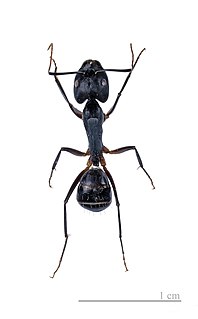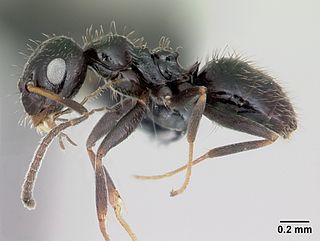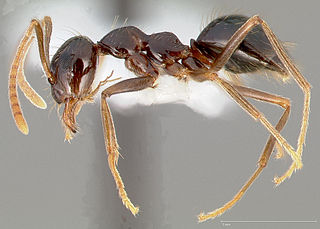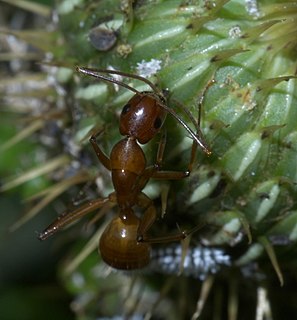
The Formicinae are a subfamily within the Formicidae containing ants of moderate evolutionary development.

Dolichoderinae is a subfamily of ants, which includes species such as the Argentine ant, the erratic ant, the odorous house ant, and the cone ant. The subfamily presents a great diversity of species throughout the world, distributed in different biogeographic realms, from the Palearctic, Nearctic, Afrotropical region and Malaysia, to the Middle East, Australian, and Neotropical regions.

The banded sugar ant, also known as the sugar ant, is a species of ant native to Australia. A member of the genus Camponotus in the subfamily Formicinae, it was described by German entomologist Wilhelm Ferdinand Erichson in 1842. Its common name refers to the ant's liking for sugar and sweet food, as well as the distinctive orange-brown band that wraps around its gaster.

Anoplolepis, also known as the "pugnacious ants", is a genus of ants in the subfamily Formicinae and tribe Lasiini. The genus is mainly found in the Afrotropics, with a few native species known from the Malagasy and Oriental regions.

Acropyga is a genus of small formicine ants. Some species can be indirect pests. A. acutiventris, which is found from India to Australia, tends subterranean, root-feeding mealybugs of the species Xenococcus annandalei. Living, gravid females are carried in the jaws of A. acutiventris queens during their nuptial flight, to establish the symbiotic association in founding colonies. Other Acropyga species have relationships with different species of mealybugs, and it could be a trait common to the whole genus.

Euprenolepis is a Southeast Asian genus of ants in the subfamily Formicinae with eight recognized species.

Lepisiota is an Old World genus of ants in the subfamily Formicinae. They nest in rotten wood, in standing trees or in the ground, generally in less forested areas.

Paraparatrechina is a genus of small ants in the subfamily Formicinae. The genus contains 31 species distributed in the tropics of Africa, Asia and Australia.

Prolasius is a genus of ants in the subfamily Formicinae. Of the genus' 19 species, 18 are known from Australia and one from New Zealand. They nest in soil under rocks or logs, sometimes in trees.

Pseudolasius is a genus of ants in the subfamily Formicinae. The genus is known from southern Asia to northern Australia, where it appears to be restricted to tropical areas.

Prenolepis is a genus of ants in the subfamily Formicinae. Most species are found in southeastern Asia and southern China, but the genus has a wide distribution with species known from North America, southern Europe, Anatolia, Cuba, Haiti, and West Africa.

Notostigma carazzii is a species of ant belonging to the genus Notostigma. The ant was first described by Emery in 1895. The species is endemic to Australia. Specimens are mainly found in the state of Queensland, and foraging workers are solitarily and nocturnal.

Notostigma foreli is a species of ant belonging to the genus Notostigma, which is native to Australia. It was described by Emery in 1920.
Camponotus irritans is a species of carpenter ant. It is found in many Asian and Oceanian countries.

The black-headed sugar ant, also known as the brown sugar ant, is a species of Formicinae ant endemic to Australia. Found throughout most states, the species is a member of the genus Camponotus, a cosmopolitan genus of ants commonly known as carpenter ants. It was formally described and named by British entomologist Frederick Smith in 1858. These ants are characterised by their black head, reddish-brown mesosoma and black gaster, which can change in colour.

Camponotus castaneus, the reddish carpenter ant, is a species of ant in the family Formicidae.

Camponotus chromaiodes, known generally as, the ferruginous carpenter ant or red carpenter ant, is a species of ant in the family Formicidae.
















